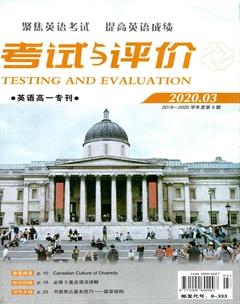Questions&Answers
张昕
【问】 有这样两个句子:
As he grew older he lost interest in everything except gardening.
Young child as he is, he knows a lot about the Internet.
请问两句中的as属于哪种用法?
(辽宁本溪 徐佳琦)
【答】 第一句中的as是连词,意思是“当……的时候”,引导时间状语从句。as引导的时间状语从句有如下特点:
1. 从句具有延续性,即使谓语是短暂动词,也要把动作放大,使其成为一个过程。例如:
I saw him as he was getting off the bus. 在他下车时,我看见了他。
2. 从句与主句的两件事彼此独立地发生或发展,只是在时间上有重叠,主句事件发生在从句事件的过程中,常可译为“随着”或“一边……,一边……”。例如:
As time passed, things seemed to get worse. 随着时间的推移,事情好像变得更糟。
3. 有时从句用省略形式,特别当从句是名词做表语表示必然经历的某一阶段的时间时,如:as a child还是个小孩时,as a student 还是个学生时。
第二句中的as引导的是让步状语从句,相当于though,意思是“虽然”。 as引导的让步状语从句有如下特点:
1) 不能像别的连词那样位于从句的首位,而居于从句首位的是从句的表语、状语或谓语中的一个动词。例如:
Young as she is, she is good at singing. 她虽然年幼,却很会唱歌。
Much as I like it, I can't afford it. 我虽然很喜欢它,却买不起。
Crying as she was, she went on with her writing. 她虽然哭着,却继续写字。
2) 表语名词置于首位时,本来有的不定冠词通常去掉。例如:
Child as she was, she wasn't a bit afraid. 她虽然是个小孩子,却一点儿也不怕。
【问】 下面这几道题我不知道如何选择,您给我讲解一下好吗?
1. It is almost five years ______ we saw each other last time.
A. before B. since C. after D. when
2. —Did Jack come back early last night?
—Yes. It was not yet eight o'clock __ __ he arrived home.
A. before B. when C. that D. until
3. —How long do you think it will be ______ China sends a manned spaceship to the moon.
—Perhaps two or three years.
A. when B. until C. that D. before
4. It was not until she got home ______Jennifer realised she had lost her keys.
A. when B. that C. where D. before
(吉林長春 王 淼)
【答】 这四道题的答案分别为B、B、D、B。题1考查的是“It be + 时间段 + since引导的时间状语从句”,句意是“自从上次我们见面以来已经近五年的时间了”。题2考查的是“It be + 时间点 + when引导的时间状语从句”,句意是“他昨晚回家时还不到8点”。题3考查“It will be + 时间段 + before”,意为“将过某段时间才……”。题4考查it在强调句型中的应用,此题是not... until...的强调句:It is / was + not until从句 + that + 句子其他部分。
before, since和when引导的时间状语从句在下列结构中较相似,容易混淆。要解答上面的题,首先要弄清楚句子的结构以及所表达的意思。
1. “It be + 时间段 + since引导的时间状语从句”表示“自从……已经有多长时间了”。主句用一般现在时或现在完成时。例如:
It is a month since I called you up. 我已有一个月没给你打电话了。
2. “It + be + 时间点 + when从句”中的it指时间,且表示时间的词语前没有介词。主句中的谓语动词和从句中的谓语动词在时态上一般是一致的,主句是will be时,when从句用一般现在时代替一般将来时。例如:
It was already 10 o'clock when we got home. 当我们到家时已经十点了。
It will be midnight when they get there. 他们到达那里时将会是半夜。
3. “It + be + 时间 + before从句”中的时间一般为表示一段时间的词语,如long, years, months, weeks, days, hours, minutes等。主句中的谓语动词用肯定式时,意为“过多长时间才……”;主句谓语动词用否定式时,意为“没过多长时间就……”。例如:
It will be some time before we know the full results. 再过些时候我们才能知道全部结果。
It won't be long before we meet each other. 我们不久就会见面的。
4. “It be + 被强调的成分(主语、宾语、状语) + that...”是强调句,表达的意思为“是……;正是……;就是……”。it在这个句型中没有实际意义。强调时间状语、地点状语要用that,而不能用when或where。例如:
It was yesterday that I met Bob in your room. 我就是昨天在你的房间遇见鲍勃的。
It was in your room that I met Bob yesterday. 我昨天就是在你的房间遇见鲍勃的。
【问】 有这样一道题:
—You should have thanked her before you left.
—I meant ______, but when I was leaving I couldn't find her anywhere.
A. to do B. to C. doing D. doing so
我选择A,而老师给的正确答案是B。我不知道自己错在哪里。
(山东泰安 郑 悦)
【答】 老师的答案是对的。本题考查动词后接动名词和动词不定式的区别及省略形式。mean后用动词不定式表示“打算;想要做某事”,后用动名词表示“意味着;意思是”。依据题意,排除C、D;第二个句子的词尾有一个不定式,该不定式是重复第一句的不定式时,可用to来代替,省去后面的原形动词,故应选B。
动词不定式的省略有以下几种情况:
1. 第二个句子的词尾有一个不定式,该不定式是重复第一句的不定式时,可用to来代替,省去后面的原形动词。例如:
—Would you like to come to dinner tonight? 你今晚愿意来吃饭吗?
—I'd like to, but I am too busy. 我愿意,但我很忙。
2. 對话的答语中含有形容词如happy, glad, eager, anxious, willing, ready, pleased, afraid等加不定式作表语结构时。例如:
—Will you help other people who are in trouble? 别人有困难时你会伸出援手吗?
—Yes, I am willing to. 是的,我乐意。
3. 不定式在句中某些动词如ask, tell, advise, force, persuade, wish, allow, permit 等后作宾语补足语或作主语补足语时常可省略。例如:
Don't touch anything unless your teacher tells you to. 不要动任何东西,除非你的老师让你做。
4. 不定式在某些动词如like, love, care, decide, hope, wish, expect, prefer, refuse, mean, try, oblige, advise, persuade等后作宾语时常可省略。例如:
—Do you want to go abroad? 你想去国外吗?
—Yes, I have decided to. 是的,我决定去。
5. 不定式在某些结构如be able to, be going to, have to, ought to等后作复合谓语时可省略。例如:
I would like to attend the meeting but I'm afraid I won't be able to. 我倒愿意参加这个会,不过我恐怕去不了。

